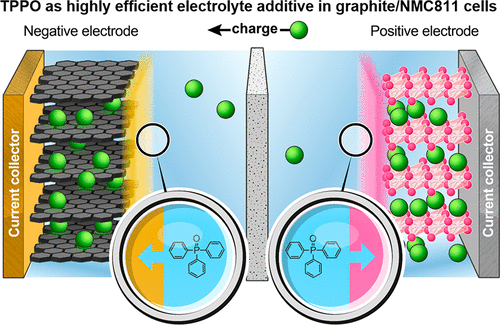当前位置:
X-MOL 学术
›
Chem. Mater.
›
论文详情
Our official English website, www.x-mol.net, welcomes your
feedback! (Note: you will need to create a separate account there.)
Triphenylphosphine Oxide as Highly Effective Electrolyte Additive for Graphite/NMC811 Lithium Ion Cells
Chemistry of Materials ( IF 7.2 ) Pub Date : 2018-03-28 00:00:00 , DOI: 10.1021/acs.chemmater.8b00413 Kolja Beltrop 1 , Sven Klein 1 , Roman Nölle 1 , Andrea Wilken 1 , Juhyon J. Lee 2 , Thomas K.-J. Köster 2 , Jakub Reiter 2 , Liang Tao 2 , Chengdu Liang 3 , Martin Winter 1, 4 , Xin Qi 1 , Tobias Placke 1
Chemistry of Materials ( IF 7.2 ) Pub Date : 2018-03-28 00:00:00 , DOI: 10.1021/acs.chemmater.8b00413 Kolja Beltrop 1 , Sven Klein 1 , Roman Nölle 1 , Andrea Wilken 1 , Juhyon J. Lee 2 , Thomas K.-J. Köster 2 , Jakub Reiter 2 , Liang Tao 2 , Chengdu Liang 3 , Martin Winter 1, 4 , Xin Qi 1 , Tobias Placke 1
Affiliation

|
Nickel-rich layered oxide materials (LiNixMnyCo1–x–yO2, x ≥ 0.8, LiNMC) attract great interest for application as positive electrode in lithium ion batteries (LIBs) due to high specific discharge capacities at moderate upper cutoff voltages below 4.4 V vs Li/Li+. However, the comparatively poor cycling stability as well as inferior safety characteristics prevent this material class from commercial application so far. Against this background, new electrolyte formulations including additives are a major prerequisite for a sufficient electrochemical performance of Ni-rich NMC materials. In this work, we introduce triphenylphosphine oxide (TPPO) as electrolyte additive for the application in graphite/LiNi0.8Mn0.1Co0.1O2 (NMC811) cells. The addition of only 0.5 wt % TPPO into a carbonate-based electrolyte (LiPF6 in EC:EMC) significantly increases the first cycle Coulombic efficiency as well as the reversible specific capacity and improves the capacity retention of the LIB full cell cycled between 2.8 and 4.3 V. Electrochemical results indicate that the full cell capacity fade is predominantly caused by active lithium loss at the negative electrode. In this contribution, X-ray photoelectron spectroscopy and inductively coupled plasma-mass spectrometry analysis confirm the participation of the electrolyte additive in the solid electrolyte interphase formation on the negative electrode as well as in the cathode electrolyte interphase formation on the positive electrode, thus, effectively reducing the active lithium loss during cycling. Furthermore, the performance of the TPPO additive is compared to literature known electrolyte additives including triphenylphosphine, vinylene carbonate, and diphenyl carbonate demonstrating the outstanding working ability of TPPO in graphite/NMC811 cells.
中文翻译:

三苯基氧化膦作为石墨/ NMC811锂离子电池的高效电解质添加剂
富镍的层状氧化物材料(的LiNi X锰ý钴1- X - Ý ø 2,X ≥0.8,LiNMC)吸引在中等上层为应用程序作为正极中的锂离子电池(LIBS)由于高比放电容量极大的兴趣低于4.4 V的截止电压vs Li / Li +。但是,相对较差的循环稳定性以及较差的安全性至今仍无法将这种材料用于商业用途。在这种背景下,包括添加剂的新电解质配方是富镍NMC材料充分电化学性能的主要前提。在这项工作中,我们引入三苯膦氧化物(TPPO)作为电解质添加剂,以用于石墨/ LiNi 0.8 Mn 0.1 Co 0.1 O 2(NMC811)电池。仅将0.5 wt%的TPPO添加到基于碳酸盐的电解质中(LiPF 6在EC:EMC中)显着提高了第一周期库仑效率以及可逆比容量,并提高了2.8至4.3 V之间循环的LIB全电池的容量保持率。电化学结果表明,全电池容量衰减主要是由活性物质引起的负极的锂损失。在此贡献中,X射线光电子能谱和电感耦合等离子体质谱分析证实了电解质添加剂参与了负极上固体电解质界面形成以及正极上阴极电解质界面形成,因此,有效减少循环过程中的活性锂损失。此外,
更新日期:2018-03-28
中文翻译:

三苯基氧化膦作为石墨/ NMC811锂离子电池的高效电解质添加剂
富镍的层状氧化物材料(的LiNi X锰ý钴1- X - Ý ø 2,X ≥0.8,LiNMC)吸引在中等上层为应用程序作为正极中的锂离子电池(LIBS)由于高比放电容量极大的兴趣低于4.4 V的截止电压vs Li / Li +。但是,相对较差的循环稳定性以及较差的安全性至今仍无法将这种材料用于商业用途。在这种背景下,包括添加剂的新电解质配方是富镍NMC材料充分电化学性能的主要前提。在这项工作中,我们引入三苯膦氧化物(TPPO)作为电解质添加剂,以用于石墨/ LiNi 0.8 Mn 0.1 Co 0.1 O 2(NMC811)电池。仅将0.5 wt%的TPPO添加到基于碳酸盐的电解质中(LiPF 6在EC:EMC中)显着提高了第一周期库仑效率以及可逆比容量,并提高了2.8至4.3 V之间循环的LIB全电池的容量保持率。电化学结果表明,全电池容量衰减主要是由活性物质引起的负极的锂损失。在此贡献中,X射线光电子能谱和电感耦合等离子体质谱分析证实了电解质添加剂参与了负极上固体电解质界面形成以及正极上阴极电解质界面形成,因此,有效减少循环过程中的活性锂损失。此外,











































 京公网安备 11010802027423号
京公网安备 11010802027423号